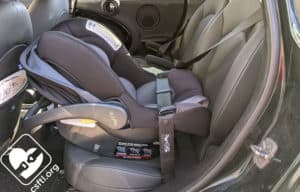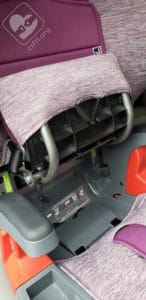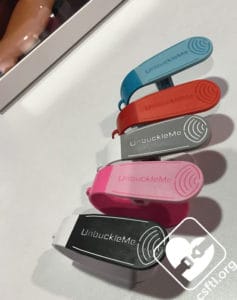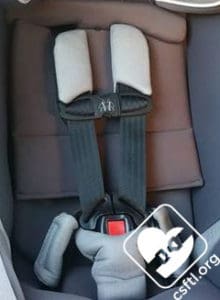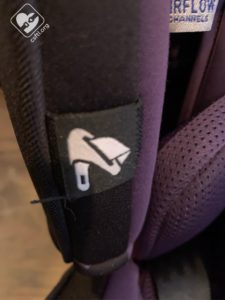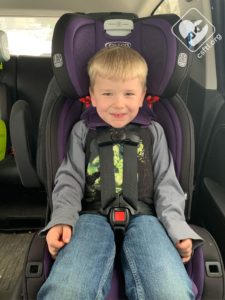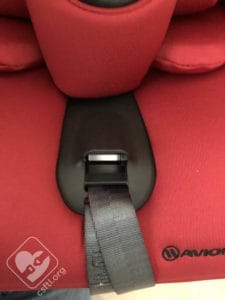As Child Passenger Safety Technicians, we often help caregivers choose the best car seat for their child and their vehicle. Some of those young passengers have additional challenges. Some CPSTs are trained in selecting and using different kinds of car seats for those unique kids.
But what about choosing car seats for caregivers who have additional physical needs? The safest car seat is the one that fits your child, fits your vehicle, and that you can use correctly every time.
Caregivers are an essential element in that equation. We count on caregivers to install and use a car seat correctly every time. How do we help caregivers who have physical challenges or differences to keep their Littles safe?
First, let’s look at the tasks a caregiver needs to be able to do daily to safely load a child in the car.
- Load the child into position in the car seat
- Adjust the harness and buckle the child in correctly
- Tighten the harness
- Release the harness and crotch buckle when the trip is over
- Unload the child from their car seat
Next, let’s consider what goes into installing a car seat. This task isn’t typically done every day — it’s done when the need arises. A caregiver who has some physical limitations could work with a CPST to learn how to install that car seat for that child in their vehicle. Installations typically require an installer to apply some type of counterpressure to compress the vehicle seat and create slack in the vehicle seat belt or lower anchors. Installing a car seat generally requires two hands but those hands don’t have to be on the same person.
Installing a car seat can absolutely be a team sport. If a caregiver’s physical abilities prevent them from doing the heavy lifting, that’s no problem if they can work with another person or a CPST to talk their way through the installation process.
Rear Facing Only Car Seats
Rear facing only car seats offer a lot of convenience in a small package. This type of car seat has two parts — a base that stays installed in the vehicle and a carrier portion that can be removed from the car.
Potential Challenges
Handles
This type of car seat has a handle on top. Adjusting the handle on the carrier requires two hands on most models. However, a few models have a one hand release — those might be a great option for caregivers who have limited mobility in their hands.
Loading the Carrier into the Vehicle
Putting a seat into a base: there’s no reason a baby can’t be unbuckled from the car and carried in, leaving the carrier in the car. On the other hand, a rear facing only car seat may be the most convenient choice for a caregiver who can’t lean into the car but can detach the carrier from the base, make her way inside and then safely unbuckle baby.
Carrier Weight
For some families, the weight of the carrier itself will be an important consideration. The new Maxi-Cosi Coral XP might be a great option for families who need a very lightweight carrier.
Carrier Release
There are various designs for the release of the carrier from the base: ideally all caregivers would have a chance to try the release lever before purchasing the seat to see if their hands can easily complete the release action.
Considerations for all Harnessed Car Seats
Ease of Installation
While we don’t expect caregivers to install their child’s car seat daily, we do know that 75% of car seats are misused, so we would like to empower all parents with the confidence to install their child’s seats. To that end, there are car seats that are easier to install than others, many of the seats that fall into the “easier to install” category include an installation mechanism that makes installing the seat far less challenging than some other models.
We’d suggest that caregivers looking for car seats that are easier to install look for these features: Britax ClickTight seat belt installation, Graco SnugLock, or Evenflo EasyLatch.
Car Seat Weight
Just like the weight of a rear facing only car seat’s carrier, the weight of a convertible or multimode car seat is another consideration when choosing a car seat. Though some car seats feature an easier vehicle seat belt installation, they may be too heavy for a family that moves them from car to car.
Convertible car seats vary in weight from 9 pounds to over 36 pounds: we encourage families to include the seat’s weight in the decision-making process, especially if they anticipate moving a seat between vehicles on a regular basis.
Crotch Buckle Release: Special Tools
Caregivers need to be able to reach and release both the crotch buckle and the chest clip. Though we know that the middle vehicle seat is the safest place in the car, for caregivers who have different abilities, the outside may be the only place that the seat can be used correctly every time. Some parents will find that buckling and unbuckling a child from inside the car is more convenient (a parent who takes her wheelchair into the car to transfer to the driver’s seat, for example).
Some crotch buckles are released from above and some are puzzle buckles. In an ideal world, all caregivers would have the opportunity to put their hands on seats before purchasing, but even just taking a look at the specifics of the hardware on the seats you are considering may save you a headache (or handache) later.
The UnbuckleMe was designed by an Occupational Therapist to help caregivers or mature children release the crotch buckle. We’ve found that it helps many caregivers who have arthritis or other challenges to release their young passengers from their harnessed car seats.
The Buckle Bopper serves a similar purpose for caregivers who have difficulty with their hands. We’ve also known some caregivers to use a large plastic duplo-style building block for the same purpose.
Chest Clips and Harness Holders
Caregivers also need to be able to release chest clip. There are many different designs for these safety items: some require a squeezing action, some require a pushing motion. We’ve found that some chest clips release more easily than others.
Many car seats include special places to store the harness when it’s not in use. If a child’s car seat does not have that storage, or it’s difficult to use, Lula Clips are an aftermarket product that attaches to the car seat cover to store the harness.
Note: though they aren’t likely to interfere with the seat’s safety, these clips aren’t tested for use with every car seat and they do tend to make small holes in the cover.
Proper Harnessing
All harnesses need to be tight enough to pass the pinch test. In small children who grow overnight, a custom fit for every ride means that the child always fits properly into the harness. Some harnesses are easier to tighten than others, but all require pulling on the webbing once the child is in the seat. For older children who can buckle themselves in and out of their seats, this may be an infrequent need: if you can leave your child’s harness properly tightened and just buckle in and out that’s a fine solution.
Harness Adjustment
There are also car seats that are easier to adjust than others as the child grows. For rear facing seats the shoulder straps need to be at or below the child’s shoulders; for forward facing seats they need to be at or above. Since kids have a pesky habit of growing, adjusting the shoulder straps is part of keeping your children safe: a design such as a no rethread harness may make more sense for a caregiver with limited physical abilities or who is dependent on a partner to reinstall.
Rotating Car Seats
There are several convertible car seats on the American market that rotate on a base that remains installed in the car. This list now includes the Cybex Sirona S, Evenflo Revolve360, Baby Jogger City Turn, Nuna REVV, and Graco Turn2Me. A rotating seat can simplify the loading of children for caregivers who need more accessible loading and unloading.
Beyond the increased accessibility, the Evenflo Revolve360’s base installs fairly easily, can be installed once, and is used for both forward facing and rear facing children. We’d definitely suggest the Revolve360 as an option for families who need to access the car seat from a reduced height. We’d suggest that caregivers consider if they can properly use the mechanism that releases the seat for rotation. A feature is only useful to you if it can be used correctly.
Empower your Passengers
Kids can help! Most caregivers know a kid who likes to do things by themselves — the trick is channeling that overwhelming energy into a useful place. Given some time, older kids can learn to climb in, to put on their harness straps, and even to buckle either themselves or a younger sibling safely.
Booster Seats
In most cases, children who are old enough, large enough, and mature enough to ride safely in a booster seat are able to buckle themselves into their boosters without much or any assistance. Because the crotch buckle on a harnessed seat is much more accessible for a caregiver leaning in the car than a seat belt buckle, we’d advocate that children who do need help getting into their booster seats should ride in a harnessed car seat instead.
In Summary
With some planning, thinking through the caregiver’s abilities plus some creative thinking, safe transport is an achievable goal for all caregivers.

